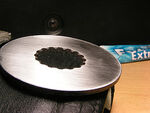When it comes to clutch, brakes and other friction based systems, the more friction we can effectively produce, the better. Most often, soft metal interfaces will produce more effective friction than hard metal interfaces, but soft metal is hard to work with since it degrades, deforms and will be worn away. This problem is resolved in most cases by a soft/hard metal interface where the wear of the soft metal is planned for.
This guide will show you how to use the process of annealing to soften the metal clutch discs inside of the clutched Evo transmissions (Evo two speed transmission and Evo slipper clutch transmission). After softening these discs, the clutch will catch more easily and more forcefully with less pressure necessary.
Required Tools[]
- Brake Cleaner
- Pliers or other grips
- Gas stove, butane torch or other super-hot/low carbon interface.
- High grit wet/dry sand paper (400 grit is preferable)
Disassemble the clutch[]
This should be obvious, but you are actually going to have to take the clutch out of the scooter in order to perform this modification. For a guide to re-assembly, see assembling the Evo two speed transmission.
Burn the clutch plates[]
video of annealing clutch plates
In order to effectively anneal the clutch plates, they will have to get hot enough to change color and let off a small amount of light.
Prepare your stove or butane torch and hold the clutch plate in a pair of pliers. Place the clutch plate into the flat at the hottest point (usually near the top/end) with the non-interface side down. By putting the side of the plate which the clutch pads don't rub facing down, we are minimizing the amount of carbon that we add to the interface (facing up).
You only need to heat the metal until it gives off the most faint amount of light. I recommend dimming the lights so this point can be more easily ascertained.
Cool the clutch plates[]
As you finish each plate, you will want to carefully cool them down. **Do not run them under water!** You could actually shatter the plate by cooling it too quickly. Simply placing it on the a cool burner of the stove or holding it until it is cool should be sufficient.
Clean the plates[]
What is required to clean the plates depends on how much carbon built up during the annealing process. If the clutch plate is blackened in any way, we will want to clean it.
If the blackening is sooty, you might be able to effectively remove it with brake cleaner. If the brake cleaner is ineffective, the plates will need to be polished. However you do it, we must have shiny steel left behind for the clutch pads to grab.
Polishing[]

Polished clutch plate
Even if you were able to remove all of the carbon with a brake cleaner, now is a great time to make sure that the interface is as smooth as it can possibly be. Contrary to popular belief, sliding friction has nothing to do with the roughness of two surfaces and you will actually increase the amount of friction by making the surfaces as smooth as possible.
When you sand down the clutch plates, 400 grit wet/dry paper should do the trick quite well. Although it will do no harm, using a grit higher than this will most likely return no noticeable benefit.
Cleanup and reassemble[]

Evo clutch pads
Before you reassemble things, you will most likely want to check the pads of the clutch "catches." These parts will wear down over time and need to be replaced. If they wear down far enough, you can damage your clutch plates while engaging our clutch. The image to the right shows a clutch catch which has pads worn to their limit.
To make sure there is no metal dust or oil on the clutch plates, it is a good idea to give them a shot of cleaner as you reassemble.
When you put things back together, make sure you have the smoothest sides of the plates touching the clutch catches. This will ensure the best connection and longest life of the catch pads. For a guide, see Assembling the Evo two speed transmission.
Results[]
Your clutch should now engage noticeably stronger than before which means it will require less force from the shifter (and your thumb) to catch the 2nd gear pulley.
See Also[]
- Evo two speed transmission
- Evo two speed transmission improvement
- Assembling the Evo two speed transmission
- Evo two speed transmission maintenance
- Evo slipper clutch transmission
